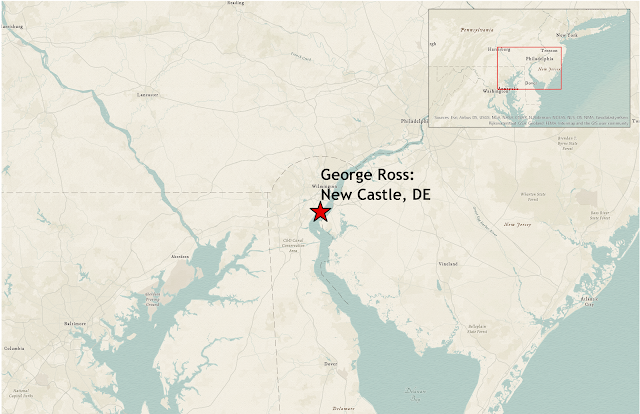Founding Fathers - George Ross
George Ross
Born: May 10, 1730 (New Castle, Delaware)
Died: July 14, 1779 (Philadelphia, Pennsylvania)
This week we'll take a look at a man who once appeared on a three cent stamp to commemorate the woman his nephew married, and is perhaps best known for being related to her. As one of sixteen children born to a Scottish Anglican minister by the name of George Aeneas Ross, George Ross' last name had come from the title his family had held since 1226 when his ancestor was named the 1st Earl of Ross by King Alexander II of Scotland. The reverend had children with two wives, and history does not record which was the mother of young George. Education was a family affair, as George was taught entirely at home before moving to Philadelphia to study law under his brother, John, in 1748. Even without a college degree, George was able to join the Pennsylvania bar two years later at 20 years of age. He decided to open his law practice in Lancaster, PA, where one of his first clients was an especially attractive woman named Ann Lawler. The two fell in love and were married in 1751, and would eventually have three children together.
The public life of George Ross began soon after his marriage, as he was named the Crown Prosecutor for the county and held the position for 12 years. His politics aligned with the British ruling class for much of his young life, and the colony as a whole was noted for maintaining a moderate stance even during polarizing events such as the Stamp Act in 1765. By 1768, Ross had developed enough of a name for himself in society that he was elected to the Pennsylvania legislature. He continued in this position for seven years until 1775, and during that time he apparently began to recognize how colonial interests were hampered by the actions of Parliament and the Crown. Despite not having any prior indication that he would support the revolutionaries, Ross was nevertheless selected as a representative to the Continental Congress in 1774 and then to the Pennsylvania Constitutional Convention the following year, where he served as the body's vice president.
George Ross continued to serve in Pennsylvania's assembly while in Congress, a less difficult task considering both governing bodies met in Philadelphia, and was involved in the state's Committee of Safety. While acting in this role, and while also a colonel in the militia, Ross led negotiations with the Northwestern Indians that led to the signing of a peace treaty. There is no record that he actively participated in the debates or votes leading up to the signing of the Declaration, indicating that he was not even present during that time. Legend has it, however, that he joined George Washington and Robert Morris on a visit to the wife of his late nephew, John, to ask her help in designing a flag. That woman, Betsy Ross, has gone down in history as the creator of the the original "Stars and Stripes" flag that became the symbol of our nation. Whether or not Ross participated in the early stages of Congress, he was certainly able to take his seat in the assembly by August 2, when the document was signed. Ross was able to affix his signature at the end of the list of nine Pennsylvania delegates. Although he was elected to another term in 1777 he became too ill to serve and resigned his position. Ross was soon appointed to a position on Pennsylvania's Court of Admiralty, where he initiated a controversy by refusing to acknowledge the authority of a national court to overturn decisions made at the state level. He only held the position for a few months, however, before his death from a severe gout attack during the summer of 1779, just two months after his 49th birthday.
The signature of George Ross can be found as the ninth name on the fourth column beneath the Declaration of Independence.




Comments
Post a Comment